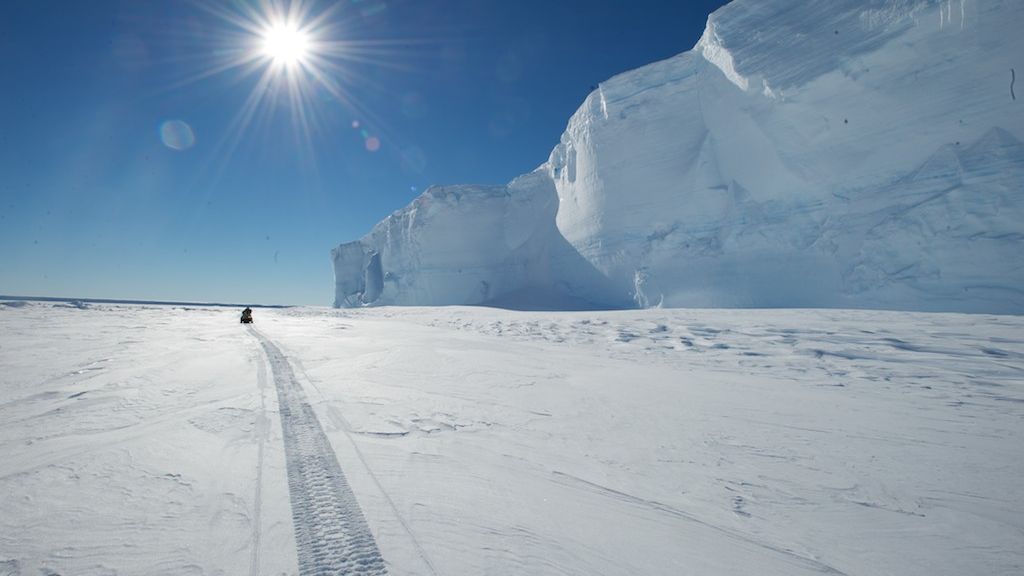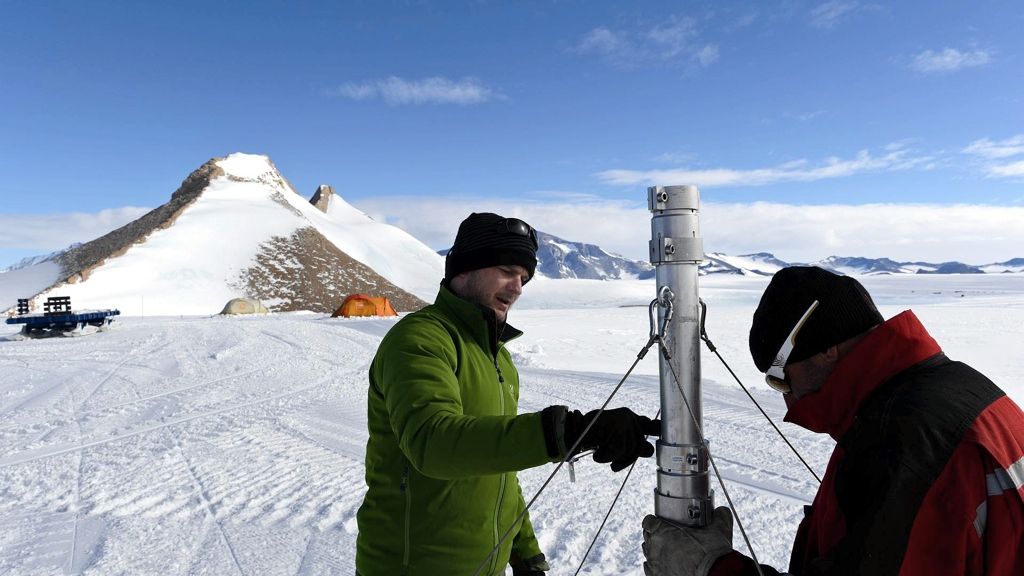The measured and the catastrophic: glacial and ice sheet melt
David Vaughan in the field in Antarctica
© DAVID VAUGHAN, BRITISH ANTARCTIC SURVEY
Professor David Vaughan of the British Antarctic Survey (BAS) discusses his ongoing research, as well as current findings, estimates, questions, and discussions about the contribution of glaciers and ice sheets to sea level rise.
There was some media controversy last year about the projected melt rate of Himalayan glaciers. What have we learned since the last Intergovernmental Panel on Climate Change (IPCC) report was published and what are today’s models predicting for glaciers and their impact on sea level rise?
What we have learned is that everything that goes into the reports issued by the IPCC has to be thoroughly checked over and over again, and the connection between the different parts of the IPCC process needs to be a lot tighter – I think that is the fundamental lesson because the idea that the Himalayan glaciers would be entirely lost within 30 years was absurd. Even the idea that all Himalayan glaciers are going to be lost within 300 years is unfounded. There will always be glaciers on the high mountains of the Himalayas because they are so high. The statement was obviously intended to convey the notion that glaciers at low altitudes in the Himalayas might melt much more rapidly than people expect, but the exact wording was clearly terrible.
To answer the second part of your question, ten years ago we actually didn’t know where ice was being lost or gained. What we know now is that most glaciated regions are currently losing ice and that this ice ends up contributing to sea level rise. But there are some mountainous regions that do not appear to be losing ice as fast as we would expect, and there are even individual glaciers and localities where ice is on the increase.
Certainly, we can highlight Alaska and the European Alps as mountainous areas that are losing mass very rapidly. Then there is the entire group of what we might call near polar glaciers systems such as Alaska, Svalbard, Patagonia, and even the warmer parts of the Antarctic, that appear to be losing mass more quickly than we originally thought they would. The reason seems to be their strong interaction with the oceans.
After years of forecasting the rapidly increasing melt and ice discharge of the Greenland Ice Sheet, your ice2sea colleagues, biologist Aud Venke Sundal and Andrew Shepherd from the School of Earth and Environment at the University of Leeds have just published a paper in Nature, which some media reported as saying that the Greenland Ice Sheet may not be as susceptible to climate change as previously thought. Can you explain these findings, and tell us what the current scenarios are for Greenland, including its future contribution to sea level rise?
Greenland responds in one of three ways to ongoing climate change. Firstly, the atmospheric temperature over Greenland warms and causes more ice melt on the surface of the ice sheet with the water generated, running off into the sea. Secondly, surface melt drains into the bed of the ice sheet, providing added lubrication and resulting in the ice flowing more rapidly into the sea. Thirdly, the ice which flows out through coastal glaciers flows into a warmer ocean, resulting in increased discharge as a result of bottom melt.
The paper that was recently published addresses the second of these processes, questioning the impact of increased surface water on glacial bed lubrication. Contrary to what was previously believed, it explains that more surface melt and water flowing through channels called moulins down to the glacial bed, does not mean that the ice will flow more rapidly. This is because eventually, large scale drainage systems form and drain the water to the sea, preventing it from spreading like a lubricating film across the entire bottom of the ice sheet.
So unlike what has been reported in newspapers, this research is not about Greenland’s entire contribution to sea level rise; it’s about that one specific process that people have hypothesized may cause rapid loss of the Greenland Ice Sheet. What the authors are saying is, “Don’t just look at the lubrication issue. Focus more on the surface melt and the ocean warming issues.” It is an extremely interesting result based on good measurements, but it doesn’t overturn the idea that Greenland will contribute to sea level rise.
What is ice2sea’s research angle in regards to the Greenland Ice Sheet? What are you finding?
What we are we doing at the moment is developing regional climate scenarios for Greenland. As with Antarctica, we are trying to understand how the climate over Greenland and in the ocean around Greenland will change in the next 100 to 200 years. But we haven’t yet begun to connect these climate changes with the new ice sheet models that we have today, so it is still too early to come up with any conclusions.
Can you summarize for us the differences between the East and West Antarctic Ice Sheets, and their contribution to sea level rise?
The East Antarctic Ice Sheet is a very stable ice sheet, which has existed for millions of years, and which rests on rock for the most part above sea level. Although it contains most of the ice in Antarctica and would raise sea levels by some 60 metres were it to melt in its entirety, currently it is neither losing nor gaining ice at a particularly rapid rate. There are regions of the ice sheet that are doing each of those things, but neither process is dominant.
The West Antarctic Ice Sheet is entirely different. Although its melting completely would result in only six meters in potential sea level rise (equivalent to a tenth of the East Antarctic Ice Sheet), it rests on rock far below sea level, and around the coastline comes into contact with a lot more warm ocean water than the East Antarctic Ice Sheet does. At the moment, what we are seeing in West Antarctica is rapid changes in a rather specific group of glaciers in the very remote Amundsen Sea region, the largest of which are the Pine Island and Thwaites Glaciers, which together account for about 10% of current global sea level rise - or 0.3mm a year overall to sea level rise. What is happening is that as the temperature of the water around Antarctica increases, it is melting the ice with which it is in contact around the edges of the ice sheet. As this takes place, glacial flow starts accelerating, the glaciers loose mass, and the change is transmitted right into the ice sheet itself as it begins to drain out more rapidly.
Is there potential for catastrophic collapse of the West Antarctic Ice Sheet?
I hesitate to use the word catastrophic, as it is never clear if it relates to the ice sheet itself, or to the rest of the world... If the question is whether the West Antarctic Ice Sheet is showing signs that it might enter a new state where it begins to retreat so much that it might disappear over the course of several centuries, then yes, I think it is possible.
Of course, the principle difficulty is that our period of observation is really short, but at the moment, I certainly don’t see any evidence that any of these processes are slowing down. The West Antarctic Amundsen Sea region is without question one which we should keep closely monitored, and into which we need to put as many resources as we can. The fact is that for many years, there was almost no research done in the region, because it is so extremely remote and difficult to work in, even by Antarctic standards. It is extremely windy and a long way away from the nearest UK and American research stations. I’ve had a two-person field party working out on Pine Island Glacier this year, and most of the 70 days they spent out on the glacier were actually spent in the tent due to bad weather.
What you are depicting does seem to be more gradual than catastrophic, but the reason I used that word is that there have been discussions about a possible sudden shift in buoyancy for the ice resting on ground below sea level, and of big sections of the West Antarctic Ice Sheet suddenly floating away before melting further north.
Indeed, you are pinpointing the specific scenario for which I would use the word catastrophic to describe the impact both for the ice sheet itself, and for the world.
And are we still talking about that possibility?
Yes we are, but I never talk about it without trying to put a time scale on it. I think it is hard to see West Antarctica deglaciating entirely on anything less than a 500 year time scale. For example, in the past, people have waved around big numbers such as a five metre sea level rise by 2100, as a result of a “catastrophic collapse” of the West Antarctic Ice Sheet. In my view, this would not be possible, and there is hardly any evidence to support this particular scenario. But this is not to say that more modest levels of sea level rise are not to be taken seriously, or indeed do not have very serious implications for low lying regions and their populations.
Does this imply that we are coming to a more measured view of these processes?
I have always hoped to give a measured view of these processes. I think the scientist’s job is not an evangelical job. Our job is to provide reliable information so that nations can choose whether to adapt and defend their coastlines or just to ignore the risk. That is part of the democratic process. The fact is that most of the sea level rise which we will see over the next hundred years is already in the system, and that there is nothing we can do now to prevent it. However, if we have a will to do it, we could do something to prevent sea level rise beyond 2100 by reducing carbon emissions.

David Vaughan
Professor Vaughan is a glaciologist who was a coordinating Lead Author for the Intergovernmental Panel on Climate Change's 4th Assessment Report and will continue in this role for the 5th Assessment Report, due to be published in 2014. He is currently also the lead-coordinator for the ice2sea research programme.





